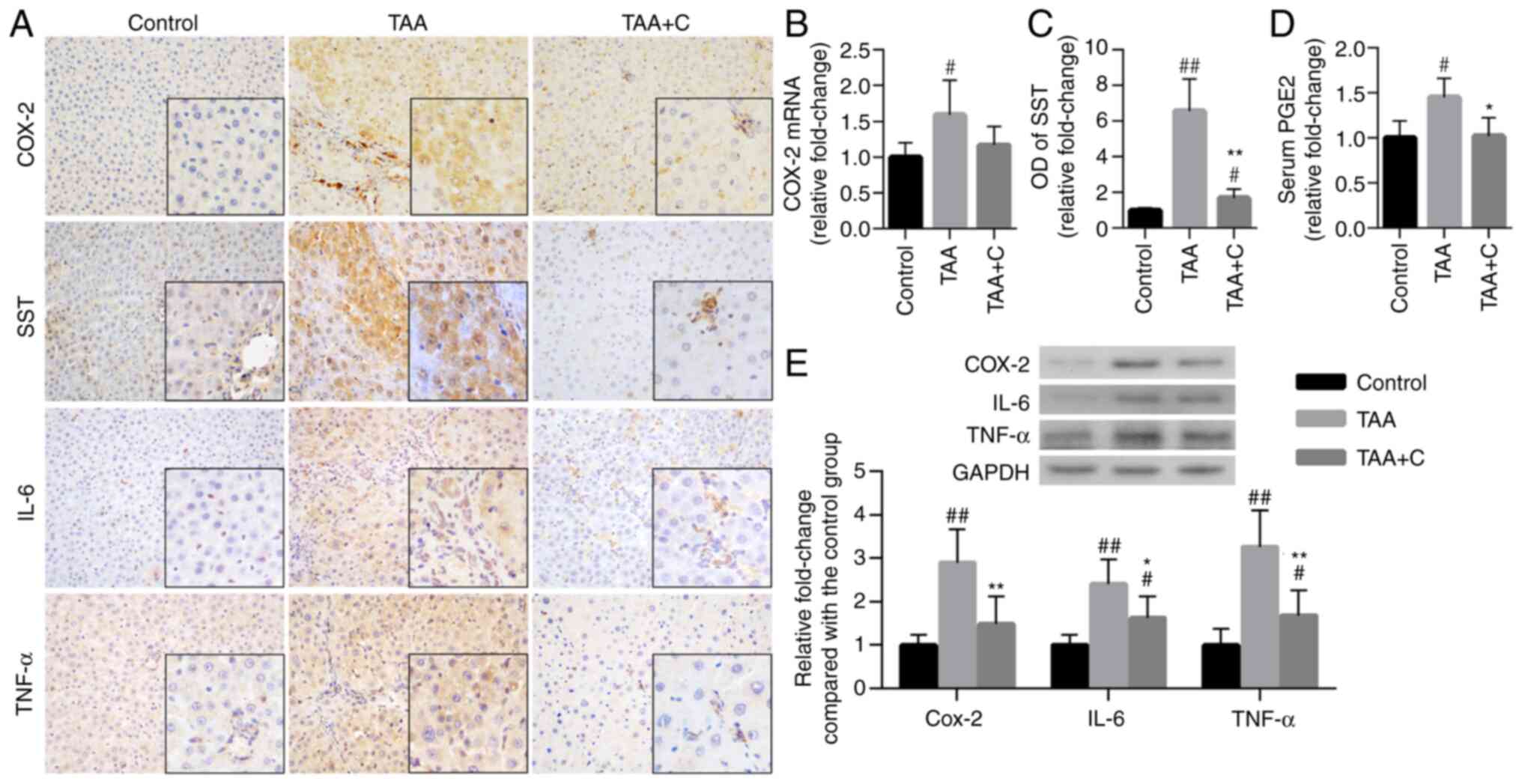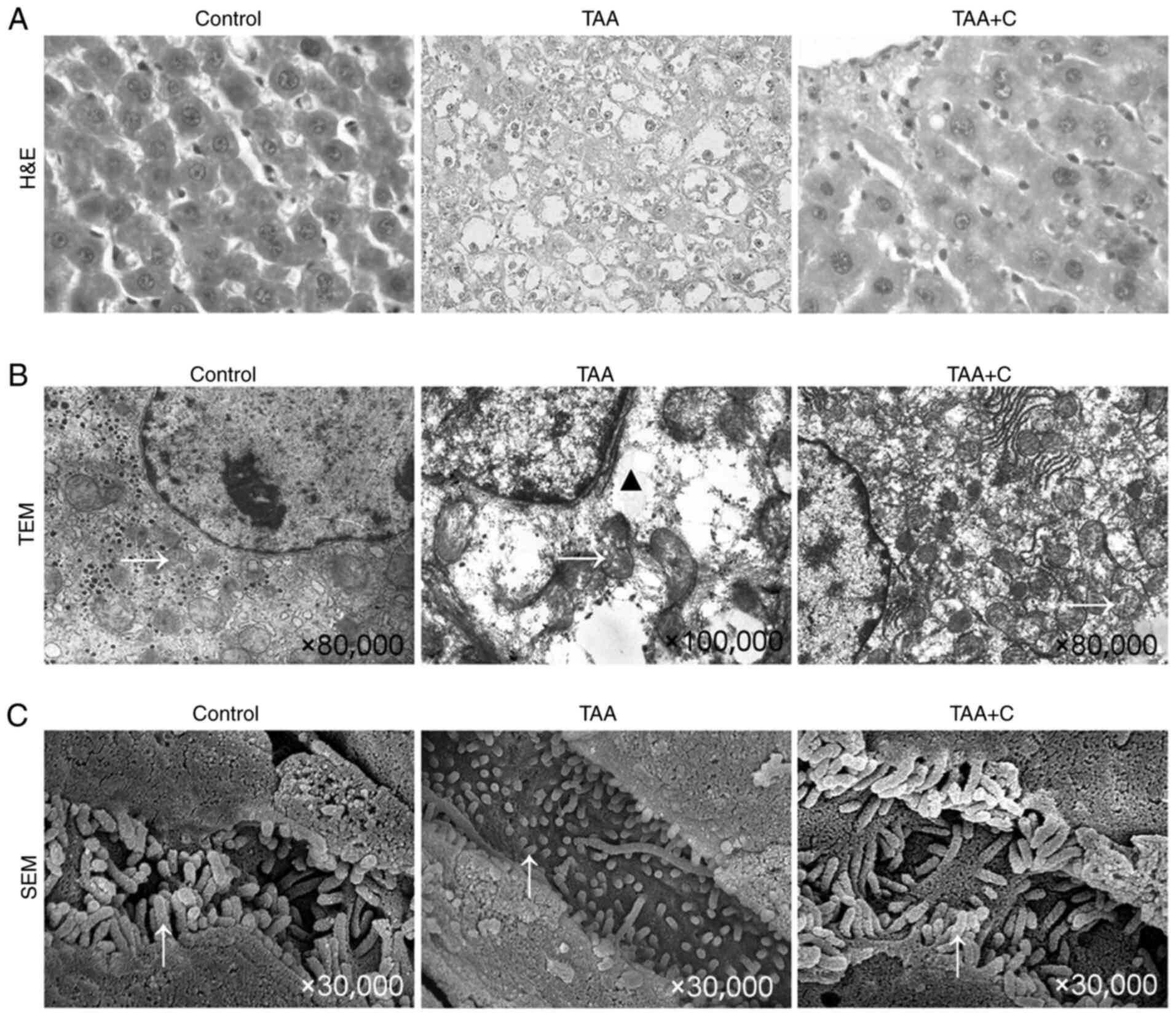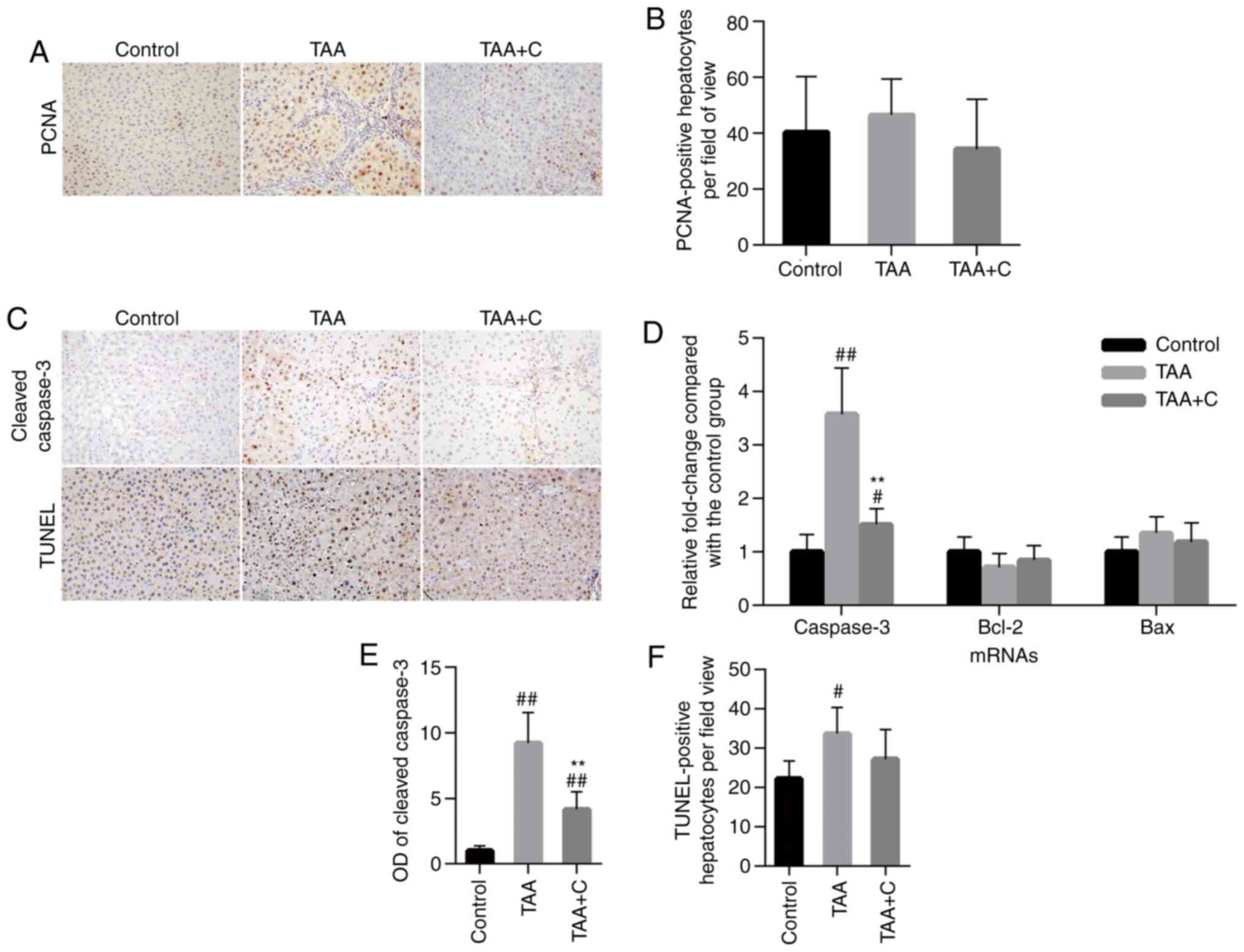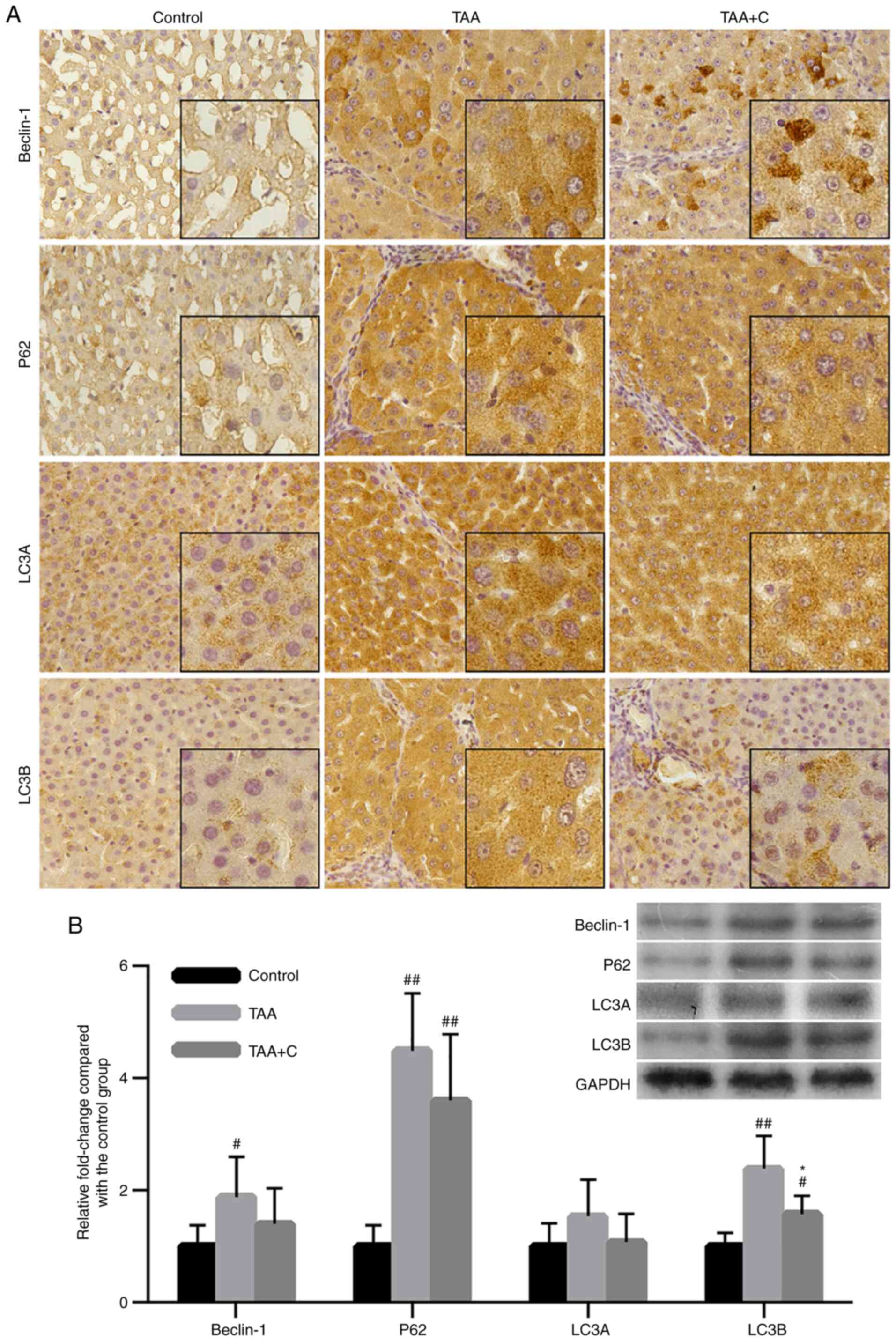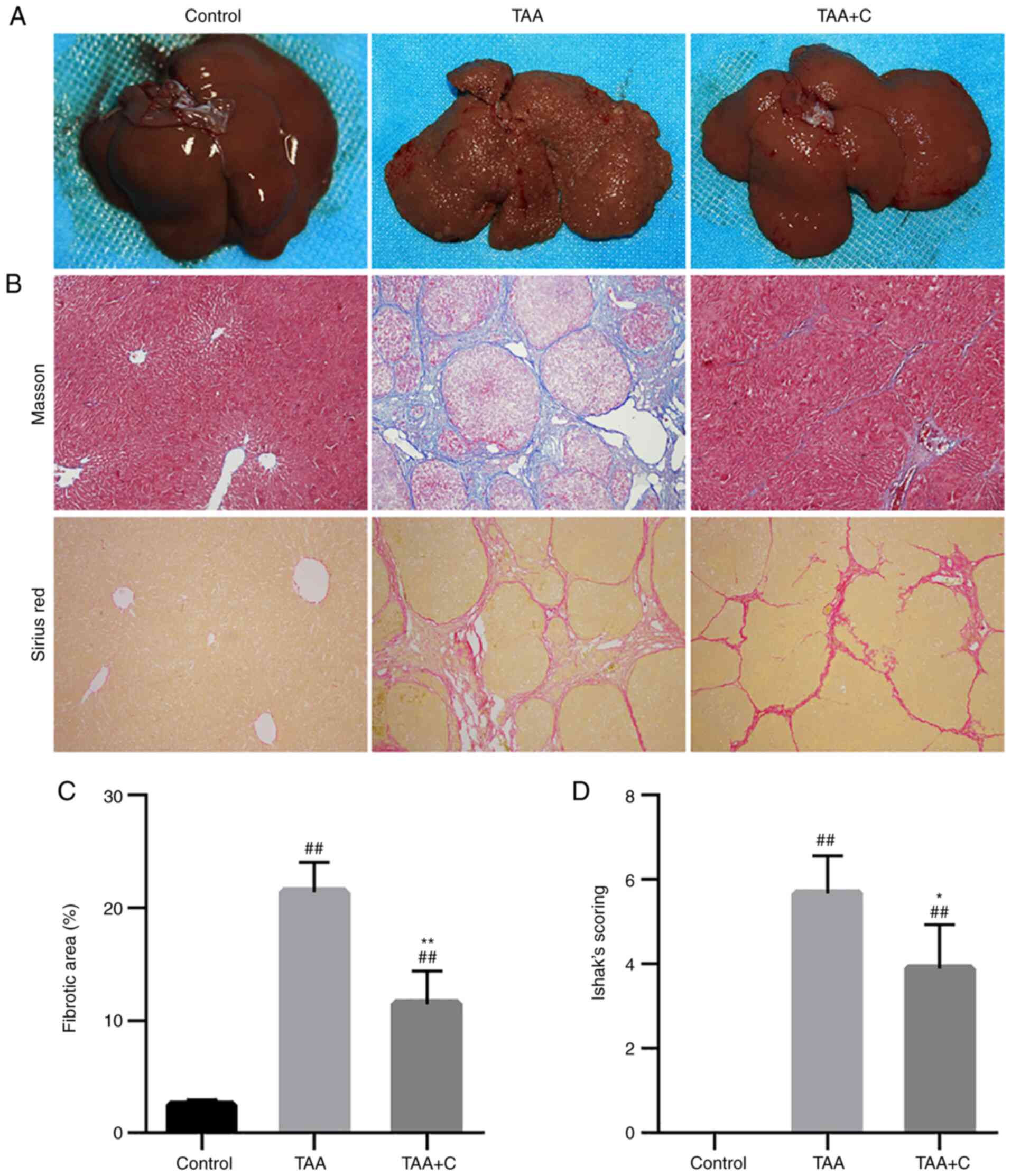|
1
|
Parola M and Pinzani M: Liver fibrosis:
Pathophysiology, pathogenetic targets and clinical issues. Mol
Aspects Med. 65:37–55. 2019.PubMed/NCBI View Article : Google Scholar
|
|
2
|
Bodzin AS and Baker TB: Liver
transplantation today: Where we are now and where we are going.
Liver Transpl. 24:1470–1475. 2018.PubMed/NCBI View
Article : Google Scholar
|
|
3
|
Shu Y, Liu X, Huang H, Wen Q and Shu J:
Research progress of natural compounds in anti-liver fibrosis by
affecting autophagy of hepatic stellate cells. Mol Biol Rep.
48:1915–1924. 2021.PubMed/NCBI View Article : Google Scholar
|
|
4
|
Campana L and Iredale JP: Regression of
liver fibrosis. Semin Liver Dis. 37:1–10. 2017.PubMed/NCBI View Article : Google Scholar
|
|
5
|
Yu K, Li Q, Shi G and Li N: Involvement of
epithelial-mesenchymal transition in liver fibrosis. Saudi J
Gastroenterol. 24:5–11. 2018.PubMed/NCBI View Article : Google Scholar
|
|
6
|
Xie G and Diehl AM: Evidence for and
against epithelial-to-mesenchymal transition in the liver. Am J
Physiol Gastrointest Liver Physiol. 305:G881–G890. 2013.PubMed/NCBI View Article : Google Scholar
|
|
7
|
Taura K, Miura K, Iwaisako K, Osterreicher
CH, Kodama Y, Penz-Osterreicher M and Brenner DA: Hepatocytes do
not undergo epithelial-mesenchymal transition in liver fibrosis in
mice. Hepatology. 51:1027–1036. 2010.PubMed/NCBI View Article : Google Scholar
|
|
8
|
Wen SL, Gao JH, Yang WJ, Lu YY, Tong H,
Huang ZY, Liu ZX and Tang CW: Celecoxib attenuates hepatic
cirrhosis through inhibition of epithelial-to-mesenchymal
transition of hepatocytes. J Gastroenterol Hepatol. 29:1932–1942.
2014.PubMed/NCBI View Article : Google Scholar
|
|
9
|
Mallat A, Lodder J, Teixeira-Clerc F,
Moreau R, Codogno P and Lotersztajn S: Autophagy: A multifaceted
partner in liver fibrosis. Biomed Res Int.
2014(869390)2014.PubMed/NCBI View Article : Google Scholar
|
|
10
|
Lee YA, Wallace MC and Friedman SL:
Pathobiology of liver fibrosis: A translational success story. Gut.
64:830–841. 2015.PubMed/NCBI View Article : Google Scholar
|
|
11
|
Rouzer CA and Marnett LJ: Cyclooxygenases:
Structural and functional insights. J Lipid Res. 50
(Suppl):S29–S34. 2009.PubMed/NCBI View Article : Google Scholar
|
|
12
|
Holt AP and Adams DH: Complex roles of
cyclo-oxygenase 2 in hepatitis. Gut. 56:903–904. 2007.PubMed/NCBI View Article : Google Scholar
|
|
13
|
Gissen P and Arias IM: Structural and
functional hepatocyte polarity and liver disease. J Hepatol.
63:1023–1037. 2015.PubMed/NCBI View Article : Google Scholar
|
|
14
|
Tulipano G and Schulz S: Novel insights in
somatostatin receptor physiology. Eur J Endocrinol. 156:S3–S11.
2007.PubMed/NCBI View Article : Google Scholar
|
|
15
|
Barnett P: Somatostatin and somatostatin
receptor physiology. Endocrine. 20:255–264. 2003.PubMed/NCBI View Article : Google Scholar
|
|
16
|
Sun L and Coy DH: Somatostatin and its
Analogs. Curr Drug Targets. 17:529–537. 2016.PubMed/NCBI View Article : Google Scholar
|
|
17
|
Li X, Benjamin IS and Alexander B:
Reproducible production of thioacetamide-induced macronodular
cirrhosis in the rat with no mortality. J Hepatol. 36:488–493.
2002.PubMed/NCBI View Article : Google Scholar
|
|
18
|
Ishak K, Baptista A, Bianchi L, Callea F,
De Groote J, Gudat F, Denk H, Desmet V, Korb G, MacSween RN, et al:
Histological grading and staging of chronic hepatitis. J Hepatol.
22:696–699. 1995.PubMed/NCBI View Article : Google Scholar
|
|
19
|
Hellemans J, Mortier G, De Paepe A,
Speleman F and Vandesompele J: qBase relative quantification
framework and software for management and automated analysis of
real-time quantitative PCR data. Genome Biol. 8(R19)2007.PubMed/NCBI View Article : Google Scholar
|
|
20
|
Kartasheva-Ebertz DM, Pol S and Lagaye S:
Retinoic acid: A new old friend of IL-17A in the immune pathogeny
of liver fibrosis. Front Immunol. 12(691073)2021.PubMed/NCBI View Article : Google Scholar
|
|
21
|
Alegre F, Pelegrin P and Feldstein AE:
Inflammasomes in liver fibrosis. Semin Liver Dis. 37:119–127.
2017.PubMed/NCBI View Article : Google Scholar
|
|
22
|
Gao JH, Wen SL, Tong H, Wang CH, Yang WJ,
Tang SH, Yan ZP, Tai Y, Ye C, Liu R, et al: Inhibition of
cyclooxygenase-2 alleviates liver cirrhosis via improvement of the
dysfunctional gut-liver axis in rats. Am J Physiol Gastrointest
Liver Physiol. 310:G962–G972. 2016.PubMed/NCBI View Article : Google Scholar
|
|
23
|
Yu J, Hui AY, Chu ES, Go MY, Cheung KF, Wu
CW, Chan HL and Sung JJ: The anti-inflammatory effect of celecoxib
does not prevent liver fibrosis in bile duct-ligated rats. Liver
Int. 29:25–36. 2009.PubMed/NCBI View Article : Google Scholar
|
|
24
|
Tahan G, Eren F, Tarçin O, Akin H, Tahan
V, Şahın H, Özdoğan O, İmeryüz N, Çelıkel Ç, Avşar E and Tözün N:
Effects of a long-acting somatostatin analogue, lanreotide, on bile
duct ligation-induced liver fibrosis in rats. Turk J Gastroenterol.
21:287–292. 2010.PubMed/NCBI View Article : Google Scholar
|
|
25
|
Hui AY, Leung WK, Chan HL, Chan FK, Go MY,
Chan KK, Tang BD, Chu ES and Sung JJ: Effect of celecoxib on
experimental liver fibrosis in rat. Liver Int. 26:125–136.
2006.PubMed/NCBI View Article : Google Scholar
|
|
26
|
Harris TR, Kodani S, Rand AA, Yang J, Imai
DM, Hwang SH and Hammock BD: Celecoxib does not protect against
fibrosis and inflammation in a carbon tetrachloride-induced model
of liver injury. Mol Pharmacol. 94:834–841. 2018.PubMed/NCBI View Article : Google Scholar
|
|
27
|
Pinzani M: Epithelial-mesenchymal
transition in chronic liver disease: Fibrogenesis or escape from
death? J Hepatol. 55:459–465. 2011.PubMed/NCBI View Article : Google Scholar
|
|
28
|
Lee SJ, Kim KH and Park KK: Mechanisms of
fibrogenesis in liver cirrhosis: The molecular aspects of
epithelial-mesenchymal transition. World J Hepatol. 6:207–216.
2014.PubMed/NCBI View Article : Google Scholar
|
|
29
|
Tsubakihara Y and Moustakas A:
Epithelial-mesenchymal transition and metastasis under the control
of transforming growth factor β. Int J Mol Sci.
19(3672)2018.PubMed/NCBI View Article : Google Scholar
|
|
30
|
Baulida J, Díaz VM and Herreros AG:
Snail1: A transcriptional factor controlled at multiple levels. J
Clin Med. 8(757)2019.PubMed/NCBI View Article : Google Scholar
|
|
31
|
Scholten D, Osterreicher CH, Scholten A,
Iwaisako K, Gu G, Brenner DA and Kisseleva T: Genetic labeling does
not detect epithelial-to-mesenchymal transition of cholangiocytes
in liver fibrosis in mice. Gastroenterology. 139:987–998.
2010.PubMed/NCBI View Article : Google Scholar
|
|
32
|
Taura K, Iwaisako K, Hatano E and Uemoto
S: Controversies over the epithelial-to-mesenchymal transition in
liver fibrosis. J Clin Med. 5(9)2016.PubMed/NCBI View Article : Google Scholar
|
|
33
|
Pinheiro D, Dias I, Ribeiro Silva K,
Stumbo AC, Thole A, Cortez E, de Carvalho L, Weiskirchen R and
Carvalho S: Mechanisms underlying cell therapy in liver fibrosis:
An overview. Cells. 8(1339)2019.PubMed/NCBI View Article : Google Scholar
|
|
34
|
Tsuchida T and Friedman SL: Mechanisms of
hepatic stellate cell activation. Nat Rev Gastroenterol Hepatol.
14:397–411. 2017.PubMed/NCBI View Article : Google Scholar
|
|
35
|
Fabregat I, Moreno-Càceres J, Sánchez A,
Dooley S, Dewidar B, Giannelli G and Ten Dijke P: IT-LIVER
Consortium. TGF-β signalling and liver disease. FEBS J.
283:2219–2232. 2016.PubMed/NCBI View Article : Google Scholar
|
|
36
|
Chen YL, Lv J, Ye XL, Sun MY, Xu Q, Liu
CH, Min LH, Li HP, Liu P and Ding X: Sorafenib inhibits
transforming growth factor 1-mediated epithelial-mesenchymal
transition and apoptosis in mouse hepatocytes. Hepatology.
53:1708–1718. 2011.PubMed/NCBI View Article : Google Scholar
|
|
37
|
Song Y, Zhao Y, Wang F, Tao L, Xiao J and
Yang C: Autophagy in hepatic fibrosis. BioMed research
international. 2014(436242)2014.PubMed/NCBI View Article : Google Scholar
|
|
38
|
Boya P, Reggiori F and Codogno P: Emerging
regulation and functions of autophagy. Nat Cell Biol. 15:713–720.
2013.PubMed/NCBI View Article : Google Scholar
|
|
39
|
Allaire M, Rautou PE, Codogno P and
Lotersztajn S: Autophagy in liver diseases: Time for translation? J
Hepatol. 70:985–998. 2019.PubMed/NCBI View Article : Google Scholar
|
|
40
|
Ke PY: Diverse functions of autophagy in
liver physiology and liver diseases. Int J Mol Sci.
20(300)2019.PubMed/NCBI View Article : Google Scholar
|
|
41
|
Tong M, Zheng Q, Liu M, Chen L, Lin YH,
Tang SG and Zhu YM: 5-methoxytryptophan alleviates liver fibrosis
by modulating FOXO3a/miR-21/ATG5 signaling pathway mediated
autophagy. Cell Cycle. 20:676–688. 2021.PubMed/NCBI View Article : Google Scholar
|
|
42
|
Kuscuoglu D, Bewersdorf L, Wenzel K, Gross
A, Kobazi Ensari G, Luo Y, Kilic K, Hittatiya K, Golob-Schwarzl N,
Leube RE, et al: Dual proteotoxic stress accelerates liver injury
via activation of p62-Nrf2. J Pathol. 254:80–91. 2021.PubMed/NCBI View Article : Google Scholar
|
|
43
|
Tan S, Liu X, Chen L, Wu X, Tao L, Pan X,
Tan S, Liu H, Jiang J and Wu B: Fas/FasL mediates
NF-κBp65/PUMA-modulated hepatocytes apoptosis via autophagy to
drive liver fibrosis. Cell Death Dis. 12(474)2021.PubMed/NCBI View Article : Google Scholar
|
|
44
|
Song M, Zhang H, Chen Z, Yang J, Li J,
Shao S and Liu J: Shikonin reduces hepatic fibrosis by inducing
apoptosis and inhibiting autophagy via the platelet-activating
factor-mitogen-activated protein kinase axis. Exp Ther Med.
21(28)2021.PubMed/NCBI View Article : Google Scholar
|
|
45
|
Dikic I and Elazar Z: Mechanism and
medical implications of mammalian autophagy. Nat Rev Mol Cell Biol.
19:349–364. 2018.PubMed/NCBI View Article : Google Scholar
|
|
46
|
Fukui H, Saito H, Ueno Y, Uto H, Obara K,
Sakaida I, Shibuya A, Seike M, Nagoshi S, Segawa M, et al:
Evidence-based clinical practice guidelines for liver cirrhosis
2015. J Gastroenterol. 51:629–650. 2016.PubMed/NCBI View Article : Google Scholar
|
|
47
|
Yoshiji H, Nagoshi S, Akahane T, Asaoka Y,
Ueno Y, Ogawa K, Kawaguchi T, Kurosaki M, Sakaida I, Shimizu M, et
al: Evidence-based clinical practice guidelines for Liver Cirrhosis
2020. J Gastroenterol. 56:593–619. 2021.PubMed/NCBI View Article : Google Scholar
|















